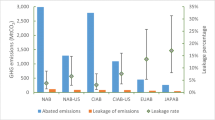Abstract
We outline the theoretical and political background to the global carbon mechanisms and how they emerged in the form of the Kyoto Protocol’s Clean Development Mechanism, Joint Implementation, and Intergovernmental Emissions Trading. We present empirical data on the response to date and the variants that have arisen. Based on this, we analyse the issues and evidence on the main controversies around additionality, efficiency and effectiveness of the instruments. The final part of the paper considers some of the implications for future development.
Similar content being viewed by others
References
Baumol WJ, Oates WE (1971) The use of standards and prices for protection of the environment. Swed J Econ 73:42–54
Begg K, Parkinson S, Jackson T, Morthorst P, Bailey P (1999) Overall issues for accounting for the emissions reductions of JI projects. In: Proceedings of the workshop on baselines for CDM, Tokyo, Japan, New Energy and Industrial Technology Development Organization, 25–26 February 1999
Cames M, Anger N, Böhringer C, Harthan R, Schneider L (2007) Long-term prospects of CDM and JI. Report to the Federal Environmental Agency of Germany, Dessau, Germany
Carbon Trust (2009) Global carbon mechanisms: emerging lessons and implications
Coase R (1960) The problem of social cost. J Law Econ 3(1):1–44
Crocker TD (1966) The structuring of atmospheric pollution control systems. In: Wolozin H (ed) The economics of air pollution. Norton, New York, pp 61–86
Dales JH (1968) Pollution, property and prices. University of Toronto Press, Toronto
Fichtner W, Graehl S, Rentz, O (2003) The impact of private investor’s transaction costs on the cost effectiveness of project-based Kyoto mechanisms. Climate Policy 3(3):249–259
Grubb M, Brack D, Vrolijk C (1999) The Kyoto Protocol: a guide and assessment. Chatham House/Earthscan, London
International Energy Agency (2008) World energy outlook IEA/OECD. International Energy Agency, Paris
IPCC (2001) Third assessment report: climate change 2001: mitigation
IPCC (2007) Working Group III Report “Mitigation of climate change”
Jackson T, Begg K (2001) Flexibility in climate policy: making the mechanisms work. Earthscan, London
Korppoo A (2007) Joint implementation in Russia and Ukraine: review of projects submitted to JISC. Climate strategies briefing paper, October 2007. Available at http://www.climatestrategies.org/reportfiles/ji_pipeline_bp_final.pdf. Accessed 17 Feb 2009
Korppoo A, Gassan-zade O (2008) ‘Joint implementation: looking back and forward’, climate strategies. Available at http://www.climatestrategies.org/our-research/category/2/78.html. Accessed 17 Feb 2009
Korppoo A, Moe A (2008) ‘Russian gas pipeline projects: case study of the dominant project type’, climate strategies. Available at http://www.climatestrategies.org/our-reports/category/19/17.html
McKinsey & Company (2009) Pathways to a low-carbon economy: version 2 of the global greenhouse has abatement cost curve. Available at: http://www.mckinsey.com/clientservice/ccsi/pathways_low_carbon_economy.asp. Accessed 16 March 2009
Michaelowa A, Stronzik M, Eckermann F, Hunt, A (2003) Transaction costs of the kyoto mechanisms. Climate Policy 3(3):261–278.
Michaelowa A, Castro P (2008) Empirical analysis of performance of CDM projects, climate strategies. Available at http://www.climatestrategies.org/component/reports/category/16/71.html. Accessed 18 Feb 2009
Montgomery WD (1972) Markets in licenses and efficient pollution control programs. J Econ Theory 5(3):395–418
Olsen K (2007) The clean development mechanism’s contribution to sustainable development: a review of the literature. Clim Change 84:59–73
Pigou AC (1920) The economics of welfare. Macmillan, London
Point Carbon (2009) Hungary considers easing budget deficit with AAU cash. Carbon Market Europe 8(8) (27 February 2009)
Purdy R (2009) Governance reform of the clean development mechanism after Poznan. Carbon and Climate Law Review (in press)
Schneider L (2007) Is the CDM fulfilling its environmental and sustainable development objectives? An evaluation of the CDM and options for improvement. Report prepared for WWF, Berlin, November 2007
Sutter C, Parreño J (2007) Does the Clean Development Mechanism (CDM) deliver its sustainable development claim? An analysis of officially registered projects. Clim Change 84:75–90
Tietenberg TH (1985) Emissions trading: an exercise in reforming pollution policy. Resources for the Future, Washington
United Nations Environment Project Risoe CDM/JI Pipeline Analysis and Database, February 1st 2009. Available at http://www.cdmpipeline.org/. Accessed 18 Feb 2009
UNFCCC (1998) Kyoto Protocol to the UNFCCC
UNFCCC (2007) Investment and financial flows to address climate change
UNFCCC (2008a) Identifying, analysing and assessing existing and potential new financing resources and relevant vehicles to support the development, deployment diffusion and transfer of environmentally sound technologies, FCCC/S B/2008/INF.7
UNFCCC (2008b) Investment and financial flows to address climate change; an update (UNFCCC/TP/2008/7)
UNFCCC (2009) Time series—annex 1 GHG data. Available at http://unfccc.int/ghg_data/ghg_data_unfccc/time_series_annex_i/items/3814.php. Accessed 12 March 2009
Urge-Vorsatz D, Tuerk A, Sharmina M, Feiler J, Qiao L (2008) Green investment schemes: maximizing their benefits for climate and society, climate strategies. Available at http://www.climatestrategies.org/our-research/category/27/104.html. Accessed 18 Feb 2009
Wara M (2006) Measuring the clean development mechanism’s performance and potential program on energy and sustainable development. Working paper 56, July 2006
Wara M, Victor D (2008) A realistic policy on international carbon offsets, program on energy and sustainable development. Working paper 74, April 2008
Author information
Authors and Affiliations
Corresponding author
Rights and permissions
About this article
Cite this article
Grubb, M., Laing, T., Counsell, T. et al. Global carbon mechanisms: lessons and implications. Climatic Change 104, 539–573 (2011). https://doi.org/10.1007/s10584-009-9791-z
Received:
Accepted:
Published:
Issue Date:
DOI: https://doi.org/10.1007/s10584-009-9791-z




